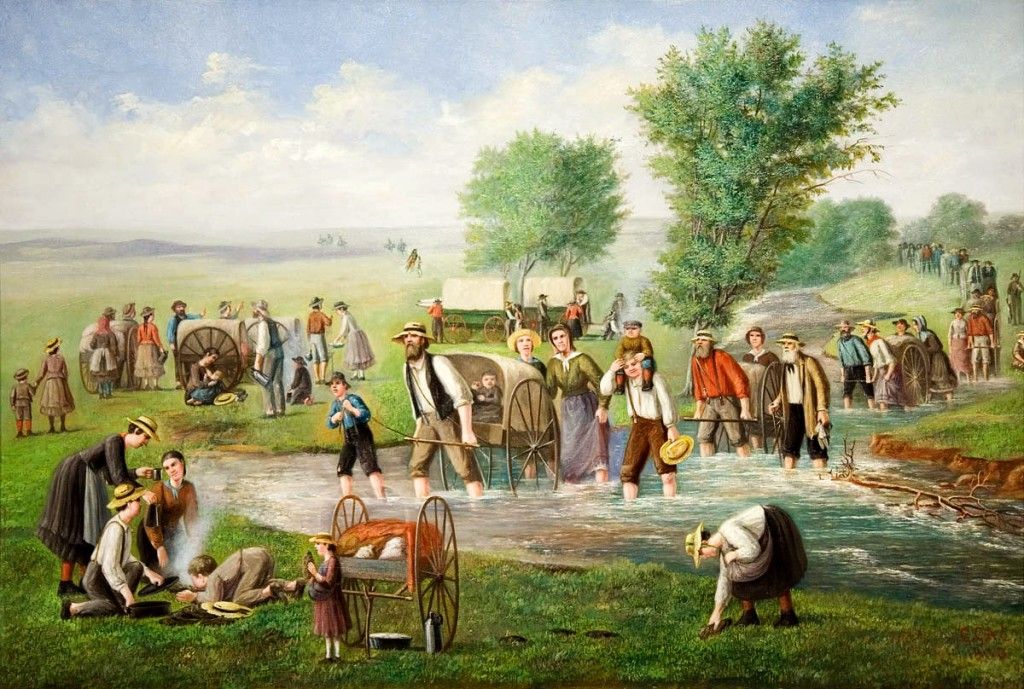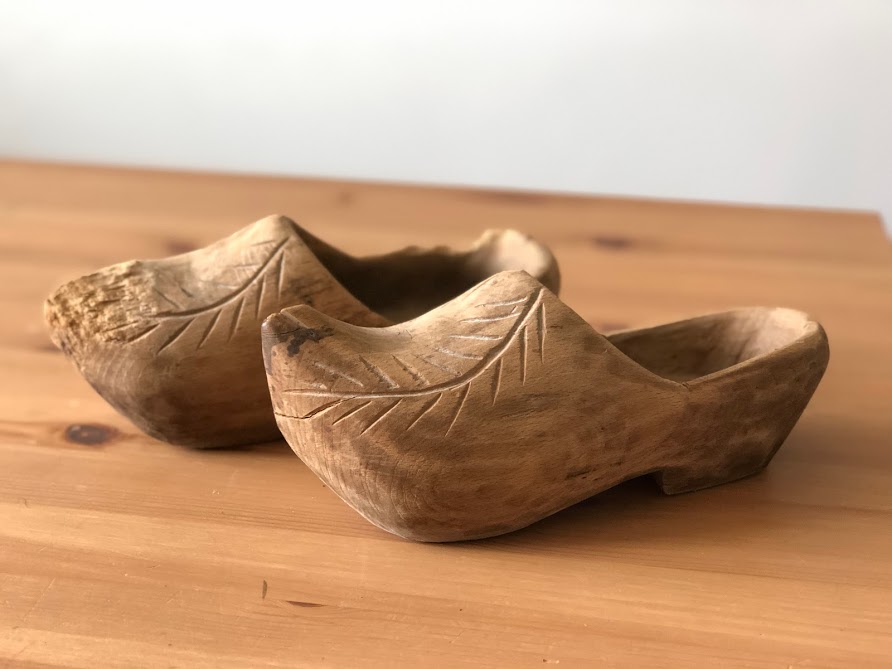Cecelia’s family went from ship, to train, to handcart (and it didn’t stop there…) on their journey from Bornholm, Denmark to Utah. So today, we turned our wagon into a handcart and went on a pretend journey from Iowa City, Iowa to Winter Quarters (now named Florence), Nebraska.
Here is more of the story that I found on FamilySearch. After arriving in Iowa City on the train,
“They were taken to campgrounds about 3 miles from town. Here large round tents capable of holding about 20 people were waiting for them. Most of them had never pitched a tent, slept on the ground, cooked out of doors or built a campfire. They had none of the skills that they would need for the trip to the Salt Lake Valley, almost 1300 miles through the Great Plains.
Hans Ancher had sold everything he had before leaving Bornholm, Denmark, believing he had enough money to buy a team of oxen and a wagon to transport his large family to Salt Lake City, after reaching Iowa City. But sometime, and it is not sure when, he entrusted a man by the name of “White” with this money. The man disappeared with the money never to be seen again, which left the family in very bad financial shape.
It is difficult to track the Kofoed family journey from Iowa to Salt Lake City. They don’t show up on emigration lists from handcart companies or wagon trains. It is believed the reason why is that they had to share carts and/or wagons with other emigrants who owned their own cart and/or wagon.
In the year 1857, Brigham Young had decided (25 October 1855) that handcarts would be easier and quicker than wagons. With no oxen to stray or be driven off by the Indians, they could cross the plains in less time and much cheaper.
The carts had hickory or oak wagon beds and hickory shafts, sidepieces, and axles. Wheels were as far apart as normal wagons wheels. Each cart carried 400 to 500 pounds of foodstuffs, bedding, clothing, and cooking utensils, and needed two able-bodied people to pull it.
Adults could take only seventeen pounds of baggage, children ten pounds. Wood bows were sometimes placed over the top and covered with canvas to provide shelter from the sun and keep the rain from getting on the contents of the handcarts.
The Scandinavian Saints from the “Westmoreland” would be with the seventh handcart company, which was first headed by James Park, David Dille and George Thurston. The company was equipped with 68 handcarts and 3 wagons drawn by teams. Christian Christiansen, who spoke Danish and English, would serve as their captain.
It is believed that the Hans Ancher Kofoed family was in this group, sharing a handcart with another family. Because she was pregnant, Cecilia was supposed to ride. However, since Cecilia could not speak English she was intimidated by the other woman who was very mean to her. The roads were sometimes sand and sometimes mud.
After crossing the Des Moines River on a bridge and approaching Council Bluffs, Iowa, officers who would not allow them to enter the city to meet the caravan. It had been rumored that the company of Saints had smallpox, so they were forced to pass west and south of the city, where they crossed the Missouri River on a steamboat ferry, near the city of Florence, Nebraska.
After reaching Florence, a council was held to consider the condition of the company. It was decided that those who were not able to keep up would remain behind and stay in Florence to become better prepared for the trek to the Valley. It was essential that the Hans Ancher family stop. Wife Cecilia was expecting a child; she was nearly six months pregnant. Other members of the family were ill.
The stay in Nebraska was not a happy time for the family, just three years of struggles, hunger and sickness. Cecilia gave birth to a little son; they named him David Omar. Little David lived less than a month; he died 19 November 1857.
Hans Ancher and Cecilia’s fourth child, a young man of 14, Hans Peter Kofoed, died 5 December 1857.
Hans Ancher’s mother Else Kirstine also died while they were living in Florence.
The “Life Sketch of Cecilia Munch,” written by some unknown family member, says this about their stay in Nebraska: “While there, their faith was tried many times. The mother (Else Kirstine), who was very ill, died. They had very little to eat, sometimes nothing. One time when they had nothing, a man by the name of Hire gave them five dollars to buy a sack of flour. When one hasn’t eaten anything or very little for some time, heavy dough bread doesn’t agree too well. As a result of this and the family not having as adequate diet, they became ill with the chills and fever. The people thought they had smallpox, so they ran them out of town, like cattle or Indians. On the outskirts of town there was a man kind enough to let them live in an old shack. This provided a meager shelter but the weather was so cold…”
Hans Ancher Kofoed looked for work, but it wasn’t easy to find a job because so many emigrants were in the same circumstances and were also trying to earn enough to come across the plains to Utah. The family was resourceful and hard working and was able to sustain themselves and still save toward the trek to the Salt Lake Valley.
In the 1860 census Hans Ancher and Cecelia family was found living in the Omaha 3rd Ward (secular not LDS). Hans Ancher was listed as “Day Laborer”. Hans Ancher and Cecilia’s oldest daughter Micelie Christine, married George Stephens and stayed in Nebraska.
Finally, on the 3rd of July 1860, the time came for Hans Ancher and his family to finish their journey to the Salt Lake Valley. They had come 300 miles by handcart, but the rest of the journey would be by any means possible. They were not able to keep the family together. A company of Saints called the “Iowa Company” was made up in Florence, Nebraska. It consisted of 123 persons, 28 wagons and one handcart. The captain of the company was John P. Taylor.
Hans Ancher and Cecelia shared one wagon with another family. Four oxen pulled it. They kept the two youngest children with them, Wilhelmine Fredericke (age 9) and Josephine Brighmine (age 5). The other children were divided up among the other emigrating families.
Jens (James) Hansen (age 11) came with Andreas Hammer and his family. Anker August ( age 9) and Johanne Margarethe (age 15) came with the Danish part of the company, with Jens Peter Christensen as the captain of their company. Christian Anton (age 20) did not come with his parents.
It was the 17th of September 1860 when Hans Ancher and his family entered the City of Salt Lake with the other members of the wagon train. The great struggle to reach the Valley was a reality they overcame.”

Hans Ancher Kofoed wore wooden shoes while crossing the plains. It is said that he wore his wooden shoes out and came part of the way barefoot. I got these shoes from ebay and the kids had fun wearing them around while we pulled our handcart.














All right! I’m glad you’re doing another pioneer unit this year. I love your photos, they always look perfect.
Thank you Carrie! We love learning more about our pioneer ancestors. :). There’s a special feeling to all of it.